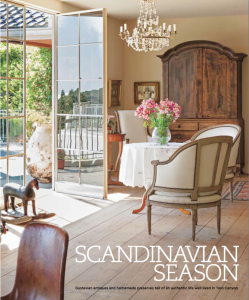 “I THINK WE HAD FOUR GUYS WORKING FOR SIX MONTHS just cutting down overgrown bushes!” laughs photographer Birgitte Aarestrup while remembering her home’s condition when she and her late husband, Leif, a renown antiques purveyor, first settled in Toro Canyon from Sweden.
“I THINK WE HAD FOUR GUYS WORKING FOR SIX MONTHS just cutting down overgrown bushes!” laughs photographer Birgitte Aarestrup while remembering her home’s condition when she and her late husband, Leif, a renown antiques purveyor, first settled in Toro Canyon from Sweden.
That proved to be a visionary plan of action because now the property’s vista expands to the Channel Islands and around to the Santa Ynez Mountains. The house itself—an innocuous 1960s teardown—somehow still spoke to the architect in Leif, and it now oozes the charm of an indeterminate European country ranch. Nineteen years later, however, the “artfully” overgrown 7.5 acres is arranged for enchanted al fresco entertaining. In the entrance courtyard, a burbling fountain large enough to bathe a St. Bernard was transported from a monastery in Austria and dates to the early 1800s. In every direction, the portal to a garden or cottage or gallery evokes a sense of travel and discovery.
Once past the main structure’s entryway with handcarved doors from India, light floods in and a whimsical folk art bird perched above peers skeptically at unwary visitors. Treasures collected during the artistic couple’s globe-trotting 50-year marriage unfold, and special picks from Leif’s collection mingle with amusingly naughty folk art and a portrait of the rather stern Swedish Queen Christina.
Leif (pronounced “life”) opened his namesake antique gallery, Lief—currently run by sons Stefan andMichael—23 years ago on the tony design strip of Melrose Place, focusing on Scandinavia’s finest artists and craftsmen. His extraordinary eye for not only style but also the pieces’ adaptability to modern settings made him the go-to for world-class furnishings. Case in point: Gustavian bergères rest on the living room’s wood floors (from an Austrian castle) and are illuminated by Paul Henningsen Danish modern lamps. “My husband was known for mixing all styles,” says Birgitte. “He said, ‘You have to select what speaks to your own eye and soul.’”
Soulful would be an understatement. Rich with history—both personal and inherited—the museum quality antiques that fill every room belie the casual warmth of the occupant’s daily life. Birgitte makes her own marmalade from oranges grown on the property and serves it up in the dining area where modernist chairs by the famed Poul Kjaerholm reside. And for those fruits that don’t make it to the table but survive the scrub jays, she partners with Unity Shoppe in Santa Barbara to redistribute the harvest’s overabundance.
When newly married and expecting their first child, the Danish-born Aarestrups purchased an old ranch in Sweden, charmed by its original 1628 structures. Not quite big enough for their growing family (and Leif’s textile company), they began moving other old structures, suiting their space needs yet maintaining the integrity of the farm’s vernacular. Fifty years later, Birgitte visits several times a year yet prefers her California life. Being in Santa Barbara, it “lifts my spirit to get up every morning in a room filled with light,” she says. Days here begin with a morning walk accompanied by a new Malamute puppy named Unalaq (“West Wind” in the Inuit language) before heading to her separate studio where a gnome is the official greeter. Once e-mails are answered, multitasking begins. She was recently appointed to the board of the Tribal Trust Foundation of Santa Barbara; an exhibit of her Sami images just opened at Seattle’s Nordic Heritage Museum; Antioch University mounted an exhibition in the fall; she recently had a book signing at the Santa Barbara Museum of Art; and is hosting a fund-raiser in December. With that hectic schedule, it’s hard to ascertain when there’s time to make that marmalade.
While photography has been a lifelong passion, it’s only become a vocation in the last 10 years. Her projects are chosen from the heart and no subject moves her more than the lives of indigenous peoples.
“I love them because I feel they are the only ones who understand how to live on this earth in balance with nature,” she says. Her recent book—8 Seasons Above the Arctic Circle, which documents the lives of the Sami people of Lapland with gritty images of man and beast— was seven years in the making, and she says she was “called” to do it. Images are handcrafted using the silver gelatin process to capture the authentic moment. Nothing posed. Nothing digital.
The gallery Leif designed and built houses Birgitte’s work, as well as a sealskin kayak from Greenland, a coat of many colors by American artist Harvey Smith, and a table from 1700. Appropriately, to enter the space, one must pass through majestic 19th century copper doors from a bank in Sweden that suggest you are about to penetrate a vault. This space—inspired by Stockholm’s Haga Castle—is now open to private events and cultural gatherings. As with fruit, Birgitte hates waste. “I feel it’s a pity for the space to be unused,” she says. “I would love to see charity events or artist salons gather.”
One imagines this is exactly what her husband would want as well— “to be surrounded with beautiful pieces lifts your spirit,” she adds. And not to share would be a waste.